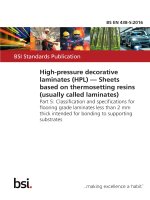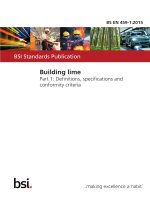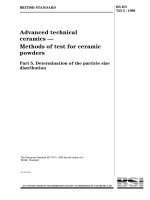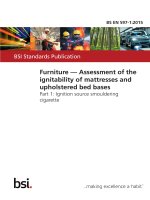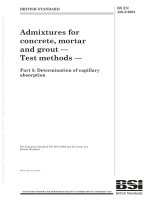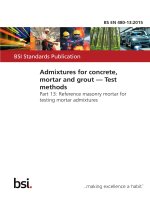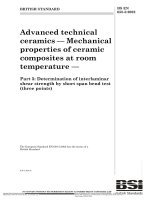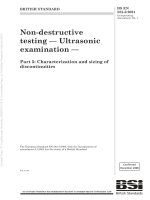Bsi bs en 61439 5 2015
Bạn đang xem bản rút gọn của tài liệu. Xem và tải ngay bản đầy đủ của tài liệu tại đây (1.7 MB, 40 trang )
BS EN 61439-5:2015
BSI Standards Publication
Low-voltage switchgear and
controlgear assemblies
Part 5: Assemblies for power distribution
in public networks
BRITISH STANDARD
BS EN 61439-5:2015
National foreword
This British Standard is the UK implementation of EN 61439-5:2015. It
is identical to IEC 61439-5:2014. It supersedes BS EN 61439-5:2011
which is withdrawn.
The UK participation in its preparation was entrusted by Technical Committee PEL/121, Switchgear and Controlgear and their assesmblies for low
voltage, to Subcommittee PEL/121/2, Low voltage switchgear and controlgear assemblies.
A list of organizations represented on this committee can be obtained on
request to its secretary.
This publication does not purport to include all the necessary provisions of
a contract. Users are responsible for its correct application.
© The British Standards Institution 2015.
Published by BSI Standards Limited 2015
ISBN 978 0 580 81085 5
ICS 29.130.20
Compliance with a British Standard cannot confer immunity from
legal obligations.
This British Standard was published under the authority of the
Standards Policy and Strategy Committee on 31 January 2015.
Amendments/corrigenda issued since publication
Date
Text affected
BS EN 61439-5:2015
EUROPEAN STANDARD
EN 61439-5
NORME EUROPÉENNE
EUROPÄISCHE NORM
January 2015
ICS 29.130.20
Supersedes EN 61439-5:2011
English Version
Low-voltage switchgear and controlgear assemblies Part 5: Assemblies for power distribution in public networks
(IEC 61439-5:2014)
Ensembles d'appareillage à basse tension Partie 5: Ensembles pour réseaux de distribution publique
(IEC 61439-5:2014)
Niederspannungs-Schaltgerätekombinationen Teil 5: Schaltgerätekombinationen in öffentlichen
Energieverteilungsnetzen
(IEC 61439-5:2014)
This European Standard was approved by CENELEC on 2014-09-29. CENELEC members are bound to comply with the CEN/CENELEC
Internal Regulations which stipulate the conditions for giving this European Standard the status of a national standard without any alteration.
Up-to-date lists and bibliographical references concerning such national standards may be obtained on application to the CEN-CENELEC
Management Centre or to any CENELEC member.
This European Standard exists in three official versions (English, French, German). A version in any other language made by translation
under the responsibility of a CENELEC member into its own language and notified to the CEN-CENELEC Management Centre has the
same status as the official versions.
CENELEC members are the national electrotechnical committees of Austria, Belgium, Bulgaria, Croatia, Cyprus, the Czech Republic,
Denmark, Estonia, Finland, Former Yugoslav Republic of Macedonia, France, Germany, Greece, Hungary, Iceland, Ireland, Italy, Latvia,
Lithuania, Luxembourg, Malta, the Netherlands, Norway, Poland, Portugal, Romania, Slovakia, Slovenia, Spain, Sweden, Switzerland,
Turkey and the United Kingdom.
European Committee for Electrotechnical Standardization
Comité Européen de Normalisation Electrotechnique
Europäisches Komitee für Elektrotechnische Normung
CEN-CENELEC Management Centre: Avenue Marnix 17, B-1000 Brussels
© 2015 CENELEC All rights of exploitation in any form and by any means reserved worldwide for CENELEC Members.
Ref. No. EN 61439-5:2015 E
BS EN 61439-5:2015
EN 61439-5:2015
-2-
Foreword
The text of document 17D/492/CDV, future edition 2 of IEC 61439-5, prepared by SC 17D "Lowvoltage switchgear and controlgear assemblies" of IEC/TC 17 "Switchgear and controlgear" was
submitted to the IEC-CENELEC parallel vote and approved by CENELEC as EN 61439-5:2015.
The following dates are fixed:
•
latest date by which the document has
to be implemented at national level by
publication of an identical national
standard or by endorsement
(dop)
2015-07-23
•
latest date by which the national
standards conflicting with the
document have to be withdrawn
(dow)
2017-09-29
This document supersedes EN 60439-5:2011.
This standard is to be read in conjunction with EN 61439-1.
Attention is drawn to the possibility that some of the elements of this document may be the subject of
patent rights. CENELEC [and/or CEN] shall not be held responsible for identifying any or all such
patent rights.
This standard covers the Principle Elements of the Safety Objectives for Electrical Equipment
Designed for Use within Certain Voltage Limits (LVD - 2006/95/EC).
This document has been prepared under a mandate given to CENELEC by the European Commission
and the European Free Trade Association, and supports essential requirements of EU Directive.
For the relationship with EU Directive see informative Annex ZZ, which is an integral part of this
document.
Endorsement notice
The text of the International Standard IEC 61439-5:2014 was approved by CENELEC as a European
Standard without any modification.
In the Bibliography of EN 61439-1:2011, the following note has to be added for the standard indicated:
ISO 9223
NOTE
Harmonised as EN ISO 9223.
BS EN 61439-5:2015
EN 61439-5:2015
-3-
Annex ZA
(normative)
Normative references to international publications
with their corresponding European publications
The following documents, in whole or in part, are normatively referenced in this document and are
indispensable for its application. For dated references, only the edition cited applies. For undated
references, the latest edition of the referenced document (including any amendments) applies.
NOTE 1 When an International Publication has been modified by common modifications, indicated by (mod), the relevant
EN/HD applies.
NOTE 2 Up-to-date information on the latest versions of the European Standards listed in this annex is available here:
www.cenelec.eu.
Annex ZA of EN 61439-1:2011 applies, except as follows:
Publication
Year
Title
EN/HD
Year
IEC 60695-11-10
2013
Fire hazard testing -EN 60695-11-10
Part 11-10: Test flames - 50 W horizontal
and vertical flame test methods
2013
IEC 61439-1
2011
Low-voltage switchgear and controlgear
assemblies -Part 1: General rules
2011
ISO 6506-1
-
Corrosion of metals and alloys EN ISO 6506-1
Corrosivity of atmospheres - Classification,
determination and estimation
Addition:
EN 61439-1
-
BS EN 61439-5:2015
EN 61439-5:2015
-4-
Annex ZZ
(informative)
Coverage of Essential Requirements of EU Directive 2004/108/EC
This European Standard has been prepared under a mandate given to CENELEC by the European
Commission and the European Free Trade Association and within its scope the standard covers all
relevant essential requirements as given in Article 1 of Annex I of the EU Directive 2004/108/EC.
Compliance with this standard provides one means of conformity with the specified essential
requirements of the Directive concerned.
WARNING: Other requirements and other EU Directives may be applicable to the products falling
within the scope of this standard.
–2–
BS EN 61439-5:2015
IEC 61439-5:2014 © IEC 2014
CONTENTS
1
Scope ............................................................................................................................ 5
2
Normative references..................................................................................................... 6
3
Terms and definitions .................................................................................................... 6
4
Symbols and abbreviations ............................................................................................ 7
5
Interface characteristics ................................................................................................. 7
6
Information .................................................................................................................... 8
7
Service conditions ......................................................................................................... 8
8
Constructional requirements .......................................................................................... 9
9
Performance requirements ........................................................................................... 11
10
Design verification ....................................................................................................... 11
11
Routine verification ...................................................................................................... 24
Annexes ............................................................................................................................. 25
Annex O (informative) Guidance on temperature rise verification ........................................ 26
Annex AA (normative) Cross-section of conductors ............................................................. 27
Annex BB (informative) Items subject to agreement between the ASSEMBLY
manufacturer and the user ........................................................................................... 29
Annex CC (informative) Design verification ......................................................................... 33
Annex DD (informative) List of notes concerning certain countries ...................................... 34
Bibliography ....................................................................................................................... 35
Figure 101 – Typical distribution network ............................................................................... 6
Figure 102 – Diagram of test to verify resistance to shock load of a PENDA-O ..................... 14
Figure 103 – Diagram of test to verify impact force withstand of a PENDA-O ........................ 15
Figure 104 – Diagram of test to verify the resistance to static load ....................................... 16
Figure 105 – Sandbag for test to verify the resistance to shock load .................................... 17
Figure 106 – Diagram of test to verify resistance to torsional stress of a PENDA-O .............. 18
Figure 107 – Diagram of test to verify the mechanical strength of doors ............................... 21
Figure 108 – Striker element for test of resistance to mechanical shock impacts
induced by sharp-edged objects .......................................................................................... 22
Figure 109 – Typical test arrangement for mechanical strength of base ................................ 23
Table 101 – Values of assumed loading ................................................................................ 8
Table 102 – Axial load to be applied to the inserts ............................................................... 22
Table AA.1 – Minimum and maximum cross-section of copper and aluminium
conductors, suitable for connection (see 8.8) ....................................................................... 27
Table AA.2 – Standard cross-sections of round copper conductors and approximate
relationship between mm 2 and AWG/kcmil sizes (see 8.8 of Part 1) ..................................... 28
Table BB.1 – Items subject to agreement between the
user 29
ASSEMBLY
manufacturer and the
Table CC.1 – List of design verifications to be performed ..................................................... 33
BS EN 61439-5:2015
IEC 61439-5:2014 © IEC 2014
–5–
LOW-VOLTAGE SWITCHGEAR AND CONTROLGEAR ASSEMBLIES –
Part 5: Assemblies for power distribution in public networks
1
Scope
This part of IEC 61439 defines the specific requirements for public electricity network
distribution assemblies (PENDAs).
PENDAs have the following criteria:
–
used for the distribution of electrical energy in three phase systems for which the rated
voltage does not exceed 1 000 V a.c. (see Figure 101 for a typical distribution network);
–
stationary;
–
open
–
suitable for installation in places where only skilled persons have access for their use,
however, outdoor types may be installed in situations that are accessible to ordinary
persons;
–
for indoor or outdoor use.
ASSEMBLIES
are not covered by this standard;
The object of this standard is to state the definitions and to specify the service conditions,
construction requirements, technical characteristics and tests for PENDAs. Network
parameters may require tests at higher performance levels.
PENDAs may also include control and or signalling devices associated with the distribution of
electrical energy.
This standard applies to all PENDAs whether they are designed, manufactured on a one-off
basis or fully standardised and manufactured in quantity.
The manufacture and/or assembly may be carried out other than by the original manufacturer
(see 3.10.1 of IEC 61439-1:2011).
This standard does not apply to individual devices and self-contained components, such as
motor starters, fuse switches, electronic equipment, etc. which comply with the relevant
product standards.
This standard does not apply to specific types of
IEC 61439 series.
ASSEMBLIES
covered by other parts of
–6–
PENDA-I or PENDA-O
BS EN 61439-5:2015
IEC 61439-5:2014 © IEC 2014
PENDA-O
Customers
MV/LV substation
Connecting points
IEC
Figure 101 – Typical distribution network
NOTE 1 If a PENDA is equipped with additional equipment (for example meters), in such a way that the main
function is changed considerably, then other standards can also apply as agreed between user and manufacturer
(see 8.5 of IEC 61439-1:2011).
NOTE 2 Where local regulations and practices permit, a PENDA according to this standard can be used in other
than public networks.
2
Normative references
This clause of Part 1 applies except as follows.
Addition:
IEC 60695-11-10:2013, Fire hazard testing – Part 11-10: Test flames – 50 W horizontal and
vertical flame test methods
IEC 61439-1:2011, Low-voltage switchgear and controlgear assemblies – Part 1: General
rules
ISO 6506-1, Metallic materials – Brinell hardness test – Part 1: Test method
3
Terms and definitions
This clause of Part 1 applies except as follows.
3.1
General terms
Additional terms:
BS EN 61439-5:2015
IEC 61439-5:2014 © IEC 2014
–7–
3.1.101
public electricity network distribution ASSEMBLY
PENDA
ASSEMBLY , generally for installation in a public electricity network which in use, receives
electrical energy from one or more supplies and distributes that energy through one or more
cables to other equipment
Note 1 to entry:
A PENDA is installed, operated and maintained solely by skilled persons.
Note 2 to entry:
Some types of a PENDA were previously known as a cable distribution cabinet (CDC).
3.1.101.1
outdoor public electricity network distribution ASSEMBLY
PENDA-O
cubicle type public electricity network distribution ASSEMBLY that is suitable for outdoor
installation in places that may, or may not, be accessible to the public
3.1.101.2
indoor public electricity network distribution ASSEMBLY
PENDA-I
public electricity network distribution ASSEMBLY suitable for installation indoors, generally
without an enclosure, but including all structural parts necessary to support busbars,
functional units and other ancillary devices, necessary to complete the ASSEMBLY
3.3
External design of
3.3.1
open-type
ASSEMBLIES
ASSEMBLY
This term of Part 1 does not apply.
3.9
Verification
Modifications:
3.9.1
design verification
Delete the note.
3.9.1.2
verification comparison
This term of Part 1 does not apply.
3.9.1.3
verification assessment
This term of Part 1 does not apply.
4
Symbols and abbreviations
This clause of Part 1 applies.
5
Interface characteristics
This clause of Part 1 applies except as follows.
BS EN 61439-5:2015
IEC 61439-5:2014 © IEC 2014
–8–
5.4
Rated diversity factor (RDF)
Addition:
In the absence of an agreement between the ASSEMBLY manufacturer and user concerning the
actual load currents, the assumed loading of the outgoing circuits of the ASSEMBLY or group of
outgoing circuits may be based on the values given in Table 101.
Table 101 – Values of assumed loading
6
Number of main circuits
Assumed loading factor
2 and 3
0,9
4 and 5
0,8
6 to 9 inclusive
0,7
10 (and above)
0,6
Information
This clause of Part 1 applies except as follows.
6.1
Assembly designation marking
Addition to first paragraph:
Designation plates may be placed inside an enclosure of an ASSEMBLY provided their intended
place ensures good legibility and visibility when the door(s) is open or the cover is removed.
Replacement of item d):
d)
6.3
IEC 61439-5.
Device and/or component identification
Additional paragraph:
In the case of removable fuse-carriers which are specific to a fuseway, a label shall be placed
on the fuse carrier as well as on the fuse base, to avoid incorrect interchangeability of the
fuse-carrier.
Additional subclause:
6.101
Circuit identification
It shall be possible to identify each functional unit in a clearly visible manner.
7
Service conditions
This clause of Part 1 applies except as follows.
7.1.1.2
Ambient air temperature for outdoor installations
Replacement of last paragraph with:
BS EN 61439-5:2015
IEC 61439-5:2014 © IEC 2014
–9–
Unless the user specifies a PENDA shall be suitable for use in an arctic climate, the lower
limit of ambient air temperature is –25 °C. For an arctic climate the lower limit of ambient
temperature is –50 °C.
7.2
Special service conditions
Addition of the following note to item h):
NOTE Exposure to vibration arising from traffic and/or occasional ground excavation is a normal service condition
for PENDAs.
Additional paragraph:
Additional requirements for a PENDA-O, to be installed where heavy snowfalls occur and
where they are adjacent to areas where there is snow clearance by ploughing, are subject to
agreement between manufacturer and user.
8
Constructional requirements
This clause of Part 1 applies except as follows.
8.1
Strength of materials and parts
8.1.1
General
Addition:
A PENDA-O shall be arranged for ground mounting, transformer mounting, pole mounting,
surface wall mounting or mounting within a recess within a wall, as agreed between user and
manufacturer.
A PENDA may be direct coupled to a transformer by means of a flange coupling or it may
connect to its supply by means of cable or via busbars as agreed between user and
manufacturer. Outgoing circuits shall be suitable for connection by means of cables.
A reliable locking device shall be provided on outdoor enclosures which prevents access by
unauthorized persons. Doors, lids and covers shall be so designed that, after they are locked,
they do not open due to subsequent moderate ground settlement, nor due to exposure to
vibration arising from traffic and/or ground excavation and reinstatement works.
8.1.3.2
Resistance of insulating materials to heat and fire
Additional subclause:
8.1.3.2.101
Verification of category of flammability
The insulating materials used for enclosures, barriers and other insulating parts shall have
flame retardant properties in accordance with 10.2.3.102 of this standard.
8.1.5
Mechanical strength
Additional subclause:
8.1.5.101
Verification of mechanical strength
The mechanical properties of a PENDA-O shall comply with 10.2.101 of this standard.
BS EN 61439-5:2015
IEC 61439-5:2014 © IEC 2014
– 10 –
Parts of the PENDA-O intended to be embedded in the ground shall withstand the stresses
imposed on them during installation and normal service and comply with 10.2.101.9.
Additional subclause:
8.1.101
Thermal stability
The thermal stability of a PENDA shall be verified according to 10.2.3.101.
8.2
Degree of protection provided by an
8.2.1
ASSEMBLY
enclosure
Protection against mechanical impact
Subclause 8.2.1 of Part 1 does not apply.
8.2.2
Protection against contact with live parts, ingress of solid foreign bodies and
water
Addition:
Open type
ASSEMBLIES
(IP00) are not covered by this standard.
When a PENDA-O is intended to be installed in places accessible to the public, its enclosure
shall, when fully-installed in accordance with the manufacturer’s instructions, provide a
degree of protection of at least IP34D according to IEC 60529. In other locations, the
minimum level of protection shall be at least IP33.
PENDA-O’s that are intended to be installed in places accessible to the public shall, unless
otherwise stated by the user, be designed such that when any temporary cables are
connected, the enclosure shall provide a degree of protection of at least IP23C according to
IEC 60529. See 8.8 of this standard.
8.4
Protection against electric shock
8.4.2.1
General
The third paragraph does not apply.
Additional subclause:
8.4.2.101
Earthing and short-circuiting means
The outgoing units in an ASSEMBLY shall be so constructed that they can be earthed and shortcircuited in a secure manner by means of a device(s) recommended by the manufacturer,
which ensures the manufacturer’s indicated degree of protection (IP code) is maintained for
all parts of the ASSEMBLY . This requirement is not applicable if it could cause a safety hazard
arising from the system conditions and/or operational practice.
8.4.3.1
Installation conditions
Additional paragraph:
For an ASSEMBLY that is expected to feed overhead cable lines, outgoing units shall be
designed in such a way that an attached cable(s) can be earthed at the termination(s).
8.8
Terminals for external conductors
Replacement of the first three paragraphs with the following:
BS EN 61439-5:2015
IEC 61439-5:2014 © IEC 2014
– 11 –
In the absence of a special agreement between user and manufacturer, terminals shall be
capable of accommodating cables having copper or aluminium conductors from the smallest
to the largest cross-sectional area corresponding to the appropriate rated current (see
Table AA.1).
The terminations for outgoing circuits shall be located so that adequate spacing is provided
and to facilitate terminating the phase conductors of a cable irrespective of their lay.
Where specified by the user, the incoming circuit shall be suitable for connection by means of
either bare or insulated bars.
Additional subclauses:
8.101
Marking as an obstacle to snow clearance
Where a PENDA-O is intended for use in regions where heavy snowfalls occur in accordance
with 7.2, or alternatively, if required by the user, it shall be possible to mark it as an obstacle
to snow clearance. Holders shall be provided, attached to the PENDA-O, to accommodate
marking rods and it shall be possible to install and make adjustments to the position of the
marking rod from outside the PENDA-O. The holders shall be constructed in a manner which
ensures that the holder or marking rod will give way to a mechanical force before the
transmitted force to the PENDA-O’s enclosure reaches the value which would adversely affect
the degree of protection (IP code).
8.102
Ease of operation and maintenance
All parts of the ASSEMBLY shall, as far as practicable, be readily accessible and replaceable
without excessive dismantling. The conditions for interchangeability of parts of the ASSEMBLY
may be subject to an agreement between the user and the manufacturer.
The design shall be such that the cables can be readily connected from the front.
When a PENDA does not have a means of measurement incorporated, it shall be possible, by
the use of a portable instrument, to readily and safely measure voltages in all phases of
incoming units and on both sides of all current breaking and/or switch devices of outgoing
units, also the current in one phase of all outgoing units. During this operation all live parts of
the PENDA shall be protected sufficiently to retain the required degree of protection in
accordance with 8.2. Instructions concerning the procedure to be adopted shall be provided
by the manufacturer.
If the ASSEMBLY is intended to be connected to a live reserve power, for example a standby
generator, the switchgear connecting device shall be designed so that connection can be
made with the live parts having a degree of protection of IP10 according to IEC 60529.
Locking arrangements shall be provided on a PENDA to secure the door(s) and prevent
unauthorised access. The fixings of any covers etc. which are removable for installation or
maintenance operations shall only be accessible while the door(s) are open.
9
Performance requirements
This clause of Part 1 applies.
10 Design verification
This clause of Part 1 applies except as follows.
– 12 –
10.1
BS EN 61439-5:2015
IEC 61439-5:2014 © IEC 2014
General
Replace 4 th , 5 th , and 6 th paragraph with:
Design verification shall only be achieved by the application of tests in accordance with
Clause 10 of this standard. The alternatives methods of verification by assessment or
comparison with a reference design shall not be used (see Table CC.1).
Tests carried out on the most onerous PENDA are deemed to verify the performance of
similar and less onerous assemblies of the same general construction and rating. For
example a temperature rise test carried out on an 800 A PENDA-O with 5 outgoing circuits is
deemed to apply to a PENDA-O of the same construction (same general design of enclosure,
same design of busbars and same incoming units) with 8 outgoing circuits of the same rating
as those included in the PENDAO that was temperature rise tested. The same approach
applies to short-circuit verification.
Additional last paragraph:
Where necessary to suit their particular network parameters, users may specify more onerous
or additional test requirements.
10.2
Strength of materials and parts
10.2.2
10.2.2.1
Resistance to corrosion
Test procedure
Replacement of last paragraph with the following:
When the corrosion resistance properties and projected life, as agreed between manufacturer
and user, can be confirmed by reference to ISO 9223, the tests detailed herein need not be
performed.
In all other cases the corrosion resistance of each design of ASSEMBLY shall be verified by
severity test A or B, as applicable and as detailed in 10.2.2.2 and 10.2.2.3 of Part 1.
10.2.2.2
Severity test A
Replacement of the test specification (paragraph 2) with the following:
Damp heat cycling test of IEC 60068-2-30: Severity – temperature 55 °C, 6 cycles and
variant 1.
At the end of the test, the specimens are removed from the test chamber.
Compliance is checked by visual inspection. The parts tested shall not show rust, cracking or
other deterioration. However, surface corrosion of the protective coating is allowed.
10.2.2.4
Results to be obtained
This subclause of Part 1 is not applicable in respect of tests carried out in accordance with
10.2.2.2.
10.2.3
Properties of insulating materials
Additional subclauses:
BS EN 61439-5:2015
IEC 61439-5:2014 © IEC 2014
10.2.3.101
– 13 –
Dry heat test
The complete ASSEMBLY shall be placed in an oven, the internal temperature of which is raised
to (100 ± 2) °C over a period of 2 h to 3 h and maintained at this temperature for 5 h.
Compliance is checked by inspection that there are no visible signs of deterioration.
Deformation of protective covers manufactured from insulating materials is acceptable if they
are more than 6 mm distant from parts which may have a temperature rise in excess of 40 K
and do not support live components.
10.2.3.102
Verification of category of flammability
Representative specimens of each of the materials of enclosures, barriers and other
insulating parts shall be subjected to a flammability test in accordance with test method A –
horizontal burning test of IEC 60695-11-10:2013.
Compliance is checked by inspection that each set of specimens can be classified to category
HB40 criteria a) or b) in accordance with 8.4.3 of IEC 60695-11-10:2013.
10.2.6
Mechanical impact
This subclause of Part 1 is not applicable to
ASSEMBLIES
complying with this standard.
Additional subclauses:
10.2.101
10.2.101.1
Verification of mechanical strength
General
The tests shall be carried out at an ambient temperature of between 10 °C and 40 °C.
With the exception of the test of 10.2.101.7, a new sample ASSEMBLY may be used for each of
the independent tests. If the same sample ASSEMBLY is used for more than one test of
10.2.101, the compliance check for the second numeral of the degree of protection (IP code)
need only be applied when the tests on that sample have been completed.
All tests shall be carried out with the ASSEMBLY fixed at its normal service mounting and where
appropriate, added support at normal ground level as indicated in Figures 102a, 102b, 103a,
and 103b.
– 14 –
BS EN 61439-5:2015
IEC 61439-5:2014 © IEC 2014
Dimensions in millimetres
300
1 000
Start position
Impact
position
Cabinet
Base
Top edge of base
Support as stated
by the manufacturer
IEC
Figure 102a – Diagram of test to verify the resistance to shock load
of a ground mounted PENDA-O with embedded base
Dimensions in millimetres
300
1 000
Start position
Impact
position
IEC
Figure 102b – Diagram of test to verify resistance to shock load
of a ground mounted PENDA-O without embedded base
Figure 102 – Diagram of test to verify resistance to shock load of a PENDA-O
BS EN 61439-5:2015
IEC 61439-5:2014 © IEC 2014
– 15 –
Dimensions in millimetres
1 000
Start position
Impact
position
Cabinet
Base
Top edge of base
Support as stated
by the manufacturer
IEC
Figure 103a – Diagram of test to verify impact force withstand
for a ground mounted PENDA-O with embedded base
Dimensions in millimetres
1 000
Start position
Impact
position
IEC
Figure 103b – Diagram of test to verify impact force withstand
for a ground mounted PENDA-O without embedded base
Figure 103 – Diagram of test to verify impact force withstand of a PENDA-O
With the exception of the test of 10.2.101.8 of this standard, the door(s) of the ASSEMBLY , if
applicable, shall be locked at the commencement of the test and remain locked for the
duration of the test.
– 16 –
10.2.101.2
BS EN 61439-5:2015
IEC 61439-5:2014 © IEC 2014
Verification of resistance to static load
The following tests shall be carried out on all types of PENDA-0:
Test 1 – An evenly distributed load of 8 500 N/m 2 shall be applied for 5 min to the roof of
the enclosure (see Figure 104).
Test 2 – A force of 1 200 N shall be applied for 5 min in turn to the front and back upper
edges of the roof of the enclosure (see Figure 104).
2
8 500 N/m
Evenly distributed load
1 200 N
Force
1 200 N
Force
IEC
Figure 104 – Diagram of test to verify the resistance to static load
Compliance is checked by verification after the test that the minimum degree of protection is
in accordance with 8.2.2, and the operation of the door(s) and locking points are not impaired;
also by verification that the electrical clearances have remained satisfactory for the duration
of the tests and in the case of an ASSEMBLY having metallic enclosure, that no contact
between live parts and the enclosure has occurred caused by permanent or temporary
distortion.
10.2.101.3
Verification of resistance to shock load
The test shall apply to all types of PENDA-O.
A bag in accordance with Figure 105 containing dry sand and having a total mass of 15 kg
shall be hung from an overhead support vertically above the surface under test and at least
1 m above the highest point of the ASSEMBLY .
BS EN 61439-5:2015
IEC 61439-5:2014 © IEC 2014
– 17 –
Dimensions in millimetres
Loop for pendulum
100
Material: any suitable flexible material
which does not burst on impact
100
Sand grain size
0,5 … 0,8
230
Eye for lifting
and release
115
Seam - only on eye
side, striking side is
seamless
∅200
IEC
Figure 105 – Sandbag for test to verify the resistance to shock load
Each test shall consist of one blow aimed at the upper part of each of the vertical surfaces of
the ASSEMBLY which are visible when the ASSEMBLY is installed in its normal service position.
Separate enclosures may be used for each of the test blows.
In the case of an enclosure of cylindrical form, the test shall consist of three blows which are
positioned with an angular displacement of 120°.
A test shall consist of raising the lifting eye through a height of 1 m and allowing the sandbag
to fall through a vertical arc to impact the approximate centre of the upper part of the surface
of the ASSEMBLY under test (see Figures 102a and 102b).
Compliance is checked by verification after the test that the degree of protection remains in
accordance with 8.2.2, and the operation of the door(s) and locking points are not impaired;
also by verification that the electrical clearances have remained satisfactory for the duration
of the tests and, in the case of an ASSEMBLY having a metallic enclosure, that no contact
between live parts and the enclosure has occurred caused by permanent or temporary
distortion. In the case of an ASSEMBLY having an insulating enclosure, if the appropriate
conditions are satisfied, then damage such as small dents or small degrees of surface
cracking or flaking are disregarded, provided that there are no associated cracks detrimental
to the serviceability of the ASSEMBLY .
10.2.101.4
Verification of resistance to torsional stress
The test only applies to all types of PENDA-O.
The test is carried out using a horizontally rotatable frame constructed from 60 mm × 60 mm ×
5 mm angle iron, having vertical locations 100 mm long at the frame arm’s extremities. The
– 18 –
BS EN 61439-5:2015
IEC 61439-5:2014 © IEC 2014
ASSEMBLY under test is rigidly fixed at its base and the frame closely fitted over it, so that the
end locations of the frame arm are in contact with the roof and walls of the ASSEMBLY .
The ASSEMBLY , with the door(s) closed shall have a torsional force of 2 × 1 000 N applied for
30 s as shown in Figures 106a and 106b.
Dimensions in millimetres
Rotatable mounting device
Angle iron
60 × 60 × 5 length 100
Force F = 1 000 N
F
F
Cabinet
Centre of rotation
F
F
Top edge of base
Base
Support as stated
by the manufacturer
PENDA-O turned in a
counter clockwise direction
PENDA-O turned in a
clockwise direction
IEC
Figure 106a – Diagram of test to verify the resistance to torsional stress
of a ground mounted PENDA-O with embedded base
Dimensions in millimetres
Angle iron
60 × 60 × 5 length 100
Rotatable mounting device
F
F
Cabinet
Centre of rotation
F
F
Force F = 1 000 N
PENDA-O turned in a
clockwise direction
PENDA-O turned in a
counter clockwise direction
IEC
Figure 106b – Diagram of test to verify resistance to torsional stress
of a ground mounted PENDA-O without embedded base
Figure 106 – Diagram of test to verify resistance to torsional stress of a PENDA-O
Compliance is checked by verifying that the doors(s) remain closed for the duration of the test
and by verification after the test that the degree of protection remains in accordance with
8.2.2.
BS EN 61439-5:2015
IEC 61439-5:2014 © IEC 2014
10.2.101.5
10.2.101.5.1
– 19 –
Verification of impact force withstand
Test applicable to PENDAs designed for operation at ambient
temperatures of between 40 °C and –25 °C
The test shall be carried out using impact apparatus in the form of a pendulum incorporating a
9 mm external diameter tube at least 1 m long. The pendulum shall be arranged to swing
through a vertical arc.
Attached to one end is a solid steel ball of 2 kg mass, which shall be raised through a height
of 1 m and allowed to drop and impact the surface of the ASSEMBLY under test, thus providing
an impact energy of 20 J (see Figures 103a and 103b).
For each of the two tests detailed below, the test shall consist of one blow aimed at the centre
of each of the vertical surfaces of the ASSEMBLY which are visible when it is installed in its
normal service position. Separate enclosures may be used for each of the test blows.
In the case of an enclosure of cylindrical form, the test shall consist of three blows which are
positioned with an angular displacement of 120°.
Test 1 shall be carried out at an ambient air temperature of between 10 °C and 40 °C after the
has been kept within these temperatures for not less that 12 h.
ASSEMBLY
Test 2 shall be carried out at an ambient air temperature of between 10 °C and 40 °C
immediately after the
not less than 12 h.
ASSEMBLY
has been kept at a temperature of −25 −00,5 °C for a period of
Compliance is checked by verification after the test that the degree of protection remains in
accordance with 8.2.2, and the operation of the door(s) and locking points are not impaired;
also by verification that the electrical clearances have remained satisfactory for the duration
of the tests and in the case of an ASSEMBLY having a metallic enclosure, that no contact
between live parts and the enclosure has occurred caused by permanent or temporary
distortion. In the case of an ASSEMBLY having an insulating enclosure, if the appropriate
conditions are satisfied, then damage such as small dents or small degrees of surface
cracking or flaking are disregarded, provided that there are no associated cracks detrimental
to the serviceability of the ASSEMBLY .
10.2.101.5.2
Test applicable to PENDAs designed for operation in an arctic climate
(see 7.1.1.2)
Following the ASSEMBLY being kept at a temperature of −50 −05 °C for a period of not less than
12 h, the impact test shall be carried out in an ambient air temperature between 10 °C and
40 °C and at a time when the external temperature of the enclosure has recovered to a
temperature not higher than –40 °C. The test sequence shall be as follows:
Tests 1 and 2 involve applying a force of 1 500 N for 30 s to an earthed metal test body
against the enclosure at the considered 10 weakest points. The test body shall be of spherical
or hemispherical shape having a radius of 100 mm ± 3 mm and a surface hardness of HB 160
according to ISO 6506-1.
Test 1 shall be carried out on an empty PENDA-O.
Test 2 shall be carried out on an ASSEMBLY containing equipment that provides the minimum
clearances inside the enclosure. A metal enclosure shall be connected to earth. For the
duration of the impact test, an a.c. voltage in accordance with 10.9.2.2 of Part 1 shall be
applied between all live parts connected together and the earth.
– 20 –
BS EN 61439-5:2015
IEC 61439-5:2014 © IEC 2014
Test 3 shall be carried out on an empty enclosure using an impact apparatus as described in
10.2.101.5.1 of this standard but having a solid steel ball with an approximate mass of 15 kg.
This striker element shall be raised through a height of approximately 1 m allowed to drop and
impact the surface of the ASSEMBLY under test, to provide an impact energy of 150 J (see
Figures 103a and 103b).
The test shall consist of one blow aimed at the centre of each of the vertical surfaces of the
which are visible when it is installed in its normal service position. Separate
enclosures may be used for each of the test blows.
ASSEMBLY
In the case of an enclosure of cylindrical form, the test shall consist of three blows which are
positioned with an angular displacement of 120°.
Compliance for Test 1 is checked by verification after the test that the degree of protection
remains in accordance with 8.2.2, and the operation of the door(s) and locking points are not
impaired.
Compliance for Test 2 is checked by verification that no puncture or flashover occurs.
Compliance for Test 3 is checked by verification after the test that the degree of the protection
is at least IP3X.
10.2.101.6
Verification of mechanical strength of doors
The test applies to all types of PENDA-O having a door(s) hinged on a vertical edge of the
enclosure.
The tests shall be carried out with the door(s) fully open and in contact with the designed
restraint. A load of 50 N shall be applied at the top edge of the door perpendicular to the
plane of the door(s) and at a distance 300 mm from the hinged edge and maintained for 3 s.
Unless the door(s) are designed to be unhinged without the use of a tool for maintenance or
operational use, the test shall then be repeated with the load increased to 450 N (see
Figure 107).
BS EN 61439-5:2015
IEC 61439-5:2014 © IEC 2014
– 21 –
Dimensions in millimetres
50 N
450 N
300
IEC
Figure 107 – Diagram of test to verify the mechanical strength of doors
Compliance is checked by verification that the door(s) have not become unhinged and the
operation of the door(s), hinges and locking points are not impaired by the application of a
load of 50 N. In addition, by verification that the degree of protection remains in accordance
with 8.2.2 after the door(s) have been closed following tests. If the door(s) become unhinged
during the 450 N test, this is not regarded as a failure if it is possible to reinstall the same
door(s) without the use of a tool.
10.2.101.7
Verification of resistance to axial load of metal inserts in synthetic
material
The test only applies to all types of ASSEMBLY when threaded metal inserts are provided to
retain the mounting plate or switchgear and controlgear supports in place.
The test shall be carried out on a representative specimen of each type and size of metal
insert. Also, if there is a difference in the thickness of the profile of the material surrounding a
particular insert, the test shall be repeated for this condition.
During the test the
ASSEMBLY
shall be fully supported on a platform.
A screw-eye shall be fitted to each insert under test and an axial force in accordance with
Table 102 of this standard shall be applied for 10 s in an attempt to extract the insert from its
anchorage.
BS EN 61439-5:2015
IEC 61439-5:2014 © IEC 2014
– 22 –
Table 102 – Axial load to be applied to the inserts
Size of insert
Axial load
N
M4
350
M5
350
M6
500
M8
500
M10
800
M12
800
Compliance is checked by inspection that the inserts remain undamaged and in their original
position; and also that there is no cracking of the surrounding material forming the anchorage
for the insert.
NOTE Small cracks, created by air bubbles that were visible before the test, but not affected by the application of
the axial load, are ignored.
10.2.101.8
Verification of resistance to mechanical shock impacts induced by
sharp-edged objects
The test applies to all types of PENDA-O.
The test shall be carried out using an impact apparatus as described in 10.2.101.5.1 of this
standard but having a steel striker element with a mass of 5 kg and having the end profiled as
shown in Figure 108.
∅2,5
Dimensions in millimetres
Hemisphere
Cone
22°
IEC
Figure 108 – Striker element for test of resistance
to mechanical shock impacts induced by sharp-edged objects
The striker element shall be raised through a height of 0,4 m and allowed to drop and impact
the surface of the ASSEMBLY under test, thus providing an impact energy of 20 J (see Figures
103a and 103b).
Each test shall consist of one blow aimed at the centre of each of the vertical surfaces of the
which are visible when the ASSEMBLY is installed in its normal service position.
Separate enclosures may be used for each of the test blows.
ASSEMBLY
In the case of an enclosure of cylindrical form, the test shall consist of three blows which are
positioned with an angular displacement of 120 o .
Test 1 shall be carried out at an ambient air temperature between 10 °C and 40 °C after the
ASSEMBLY has been kept within these temperatures for not less than 12 h.
